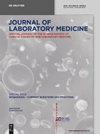健康和疾病中的氧化应激和抗氧化剂
IF 1.1
4区 医学
Q4 MEDICAL LABORATORY TECHNOLOGY
引用次数: 9
摘要
摘要内源性或外源性活性氧和活性氮物质形成的增加会由于促氧化剂和抗氧化剂失衡而导致氧化应激,从而导致代谢中的细胞损伤。这会增加细胞炎症、细胞凋亡和坏死、DNA碱基损伤、DNA和蛋白质交联、脂质膜过氧化和线粒体功能障碍。抗氧化剂可以被描述为一种保护生物分子和生物体免受自由基有害影响、减少或修复活性氧(ROS)对目标分子造成的损伤的系统,这被称为抗氧化防御。已知氧化应激引起的ROS增加所引起的机制与许多疾病的病理学正相关,如癌症、代谢综合征、动脉粥样硬化、疟疾、阿尔茨海默病、类风湿性关节炎、神经退行性疾病和先兆子痫。本文章由计算机程序翻译,如有差异,请以英文原文为准。
Oxidative stress and antioxidants in health and disease
Abstract The increase in the formation of reactive oxygen and reactive nitrogen species of endogenous or exogenous origin causes oxidative stress due to pro-oxidant and antioxidant imbalance that causes cellular damage in metabolism. This can increase inflammation of cells, apoptosis and necrosis, damage to DNA base damage, DNA and protein cross-links, lipid membrane peroxidation, and mitochondrial dysfunction. Antioxidants can be described as a system that protects biomolecules and the organism against the harmful effects of free radicals, reduces or repairs the damage done by reactive oxygen species (ROS) to the target molecule, and this is called antioxidant defense. It is known that the mechanisms caused by the increase in ROS resulting from oxidative stress are positively related to the pathology of many diseases such as cancer, metabolic syndrome, atherosclerosis, malaria, Alzheimer’s disease, rheumatoid arthritis, neurodegenerative diseases and preeclampsia.
求助全文
通过发布文献求助,成功后即可免费获取论文全文。
去求助
来源期刊

Journal of Laboratory Medicine
Mathematics-Discrete Mathematics and Combinatorics
CiteScore
2.50
自引率
0.00%
发文量
39
审稿时长
10 weeks
期刊介绍:
The Journal of Laboratory Medicine (JLM) is a bi-monthly published journal that reports on the latest developments in laboratory medicine. Particular focus is placed on the diagnostic aspects of the clinical laboratory, although technical, regulatory, and educational topics are equally covered. The Journal specializes in the publication of high-standard, competent and timely review articles on clinical, methodological and pathogenic aspects of modern laboratory diagnostics. These reviews are critically reviewed by expert reviewers and JLM’s Associate Editors who are specialists in the various subdisciplines of laboratory medicine. In addition, JLM publishes original research articles, case reports, point/counterpoint articles and letters to the editor, all of which are peer reviewed by at least two experts in the field.
 求助内容:
求助内容: 应助结果提醒方式:
应助结果提醒方式:


